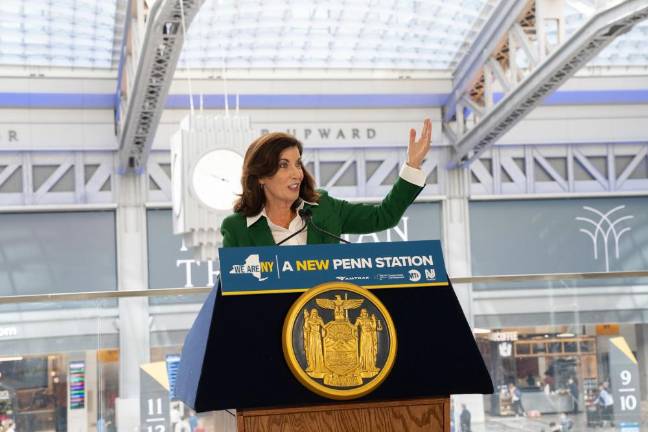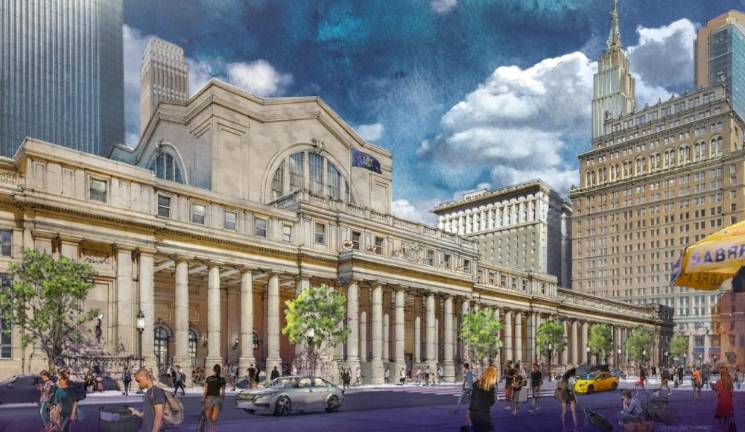Once upon a rather different time, the Pennsylvania Railroad, then the nation’s second largest corporation, decided it could no longer deposit its New York bound passengers in New Jersey to cross the North River by ferry boats.
So it tunneled under the river and built a resplendent Pennsylvania Station, paid for entirely out of its own ample coffers.
“The Pennsylvania is preparing to pour out money like water for the privilege of placing a station in the heart of the nation’s metropolis,” the New-York Tribune marveled, to use the evocative verb of author Jill Jonnes, who chronicled the endeavor in her book, “Conquering Gotham.”
That was then, 120 years ago, in a Glided Age when the Great City seemed capable of such marvels of public building (as distinct from this Gilded Age when, well, not).
With that original Penn Station long interred in what we can now recognize as the city’s defining development tragedy, the “privilege” of placing a station in the heart of the metropolis is something no one wants to pay for.
Solving that dilemma is what has landed us in the current controversy about renovating Penn Station.
It would be hard to find anyone against a new station. Aptly described as the worst train station in North America, the current Penn Station resembles what’s left after a tooth is extracted.
That original masterpiece was yanked down in 1963 and capped by Madison Square Garden and some office towers, crunching access to the trains through a warren of dark and narrow corridors below street level.
Indeed, the tragedy of losing one of the city’s architectural masterpieces was compounded because the successor station, built at no cost to the then financially failing railroad, had to conform to the needs of the people paying the bills, the developers of the Garden and the rest of the space above.
“So station configuration and design efficiency took a back seat to the structural requirements of the buildings that were constructed above the station,” the state’s development corporation wrote last year. “This lack of attention to the architectural needs of a major train station resulted in a dysfunctional layout ... The existing station consists of vestiges of the below ground portions of the original structure, punctuated at all levels by structural columns that support MSG and 2 Penn Plaza.”
This engineering trade-off can be followed all the way back to the original station. Charles McKim, the architect, convinced alexander Cassatt, president of the Pennsylvania, to abandon plans for an eighteen story hotel above the station.
Such a tower, Jill Jonnes reports, would have cut two or more tracks from the terminal and, as the railroad’s directors concluded, made “the railroad business a secondary feature.”
Renovated and Renamed Station
Which brings us to the current plan to pay for a renovated (and renamed) Empire Station by granting a developer, Steven Roth’s Vernado Realty Trust, the privilege to build ten towers around the station and using some of the revenue generated by this development to pay for the new station.
This deal was made by then Governor Andrew Cuomo. His successor, Kathy Hochul, has stuck with it, although she has sought to emphasize, and accelerate, renovating the station and various public amenities in the neighborhood.
This does not appear to be placating the community opponents, who say the plan will bulldoze a classic New York neighborhood, make a developer even richer through anodyne skyscrapers and, in the end, still not really fix the train station.
“Will the governor really evict Capuchin monks who have taken a vow of poverty and serve the poor,” implored the opponents, citing one group of residents who will be dislocated.
“The Governor and Vornado aim to replace The Friars, their home, and their church with yet another luxury supertall tower.”
Different Vision
The opponents, gathered under the umbrella of the Empire Station Coalition, pulled hard on the heartstrings at a recent event, trying to draw attention to the Monks and other local residents and businesses in the path of the project.
But they also offered an entirely different vision. They argued that the Governor is thinking about this all wrong and that the plan was just putting “lipstick on the pig” of a dysfunctional facility.
The only way to fix the real problem, they argue, is to move Madison Square Garden, perhaps to the parking area by the Javits Convention Center or on a yet-to-be constructed deck over the western end of the rail yard between the river and Hudson Yards, which already covers the eastern portion of the rail yard.
Moving the Garden would, of course, be a major expense in itself, and Hochul got herself in a good bit of political soup just recently by committing the state to subsidize a new stadium for the Buffalo Bills.
Be that as it may, Samuel Turvey, the chair of ReThinkNYC and co-coordinator of the Empire Station coalition, said the above ground station won’t cost more than the state is already estimating as the cost of renovating the below ground station, about $7 billion.
This would be covered 80 percent by federal infrastructure money, Turvey noted and “the station we recommend would be magnitudes superior.”
The state should pay its share from general revenue rather than the revenue skimmed from the Vornado development, Turvey said.
“We believe the Vornado plan is unnecessary to fund the station,” Turvey said. “We also believe it has all the earmarks of a corporate bailout as Vornado’s stock price has been in decline for some time.”
“Overwhelming Attractiveness”
The new station Turvey’s group is recommending would be quite familiar – a recreation of the original McKim, Mead and White Pennsylvania Station, updated with 21st century technology and amenities.
“Given its overwhelming attractiveness as a place to use and visit, a rebuilt and modernized original Penn Station will pay for itself through the positive economic impact it will most certainly have on the neighborhood, city and tri-state area,” Turvey said.
Sixty years after its destruction, one of the great architectural monuments of New York would rise again.
“What would be really tragic,” Turvey added, “is to spend billions of dollars on an underground Penn Station only to have MSG decide to move in five years (MSG is the oldest arena in the NBA and has already moved 4 times) and leave us with a colossal waste of money on a decidedly suboptimal station.”

